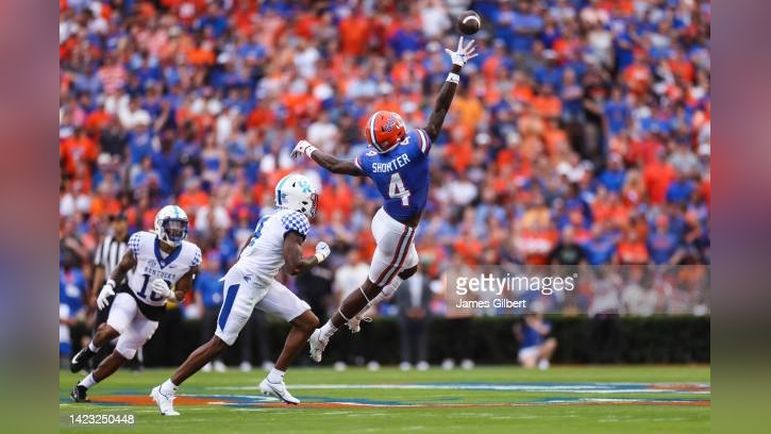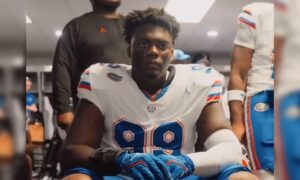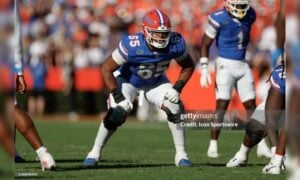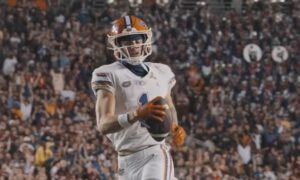From now until the 2023 NFL Draft, we will scout and create profiles for as many prospects as possible, examining their strengths, weaknesses, and what they can bring to an NFL franchise. These players could be potential top-10 picks, all the way down to Day Three selections and priority undrafted free agents. Today I’ll be profiling Florida WR Justin Shorter.
#4 Justin Shorter/WR Florida – 6036, 229 lbs. (Redshirt Junior)
Shrine Bowl/Combine
Measurements
| Player | Ht/Wt | Hand Size | Arm Length | Wingspan |
| Justin Shorter | 6036, 229 | 10 | 33 3/4 | N/A |
| 40-Yard Dash | 10-Yard Dash | Short Shuttle | 3-Cone | |
| 4.55 | 1.59 | DNP | DNP | |
| Broad Jump | Vertical | Bench Press | ||
| 10’6″ | 35.5 | 18 |
The Good
— Capable of using his frame and strength to manhandle defensive backs as a blocker
— Possesses rare size for the position, which makes him a great target working over the middle of the field
— Elite catch radius, uses his large frame to box defenders out at the catch point
— Has a great feel for navigating zone coverage and settling in open areas
— Does well to work himself into his quarterback’s vision late in routes
— Consistently falls forward on tackles
— Has experience aligned as both an X and Z receiver, as well as working out of the slot
—Does a nice job to transition from a route runner into a blocker, his game translates well in many facets of playing with a mobile quarterback
—Does a nice job adjusting and using his body to protect from the ground and secure low-point catches to bail out his quarterbacks on short-armed throws
—Great at the catch point on vertical targets, flashes late hands and has the size to high point the football without leaving the ground. He is a legitimate deep threat despite lacking burner speed
—Does well to track deep balls over the shoulder, allowing him to make difficult catches while keeping defenders on his back
— Should be capable of providing some inside/outside versatility at the next level, although I think his best role is likely as a big slot
— Size and physical advantages allow him to muscle defenders at the top of the routes to create separation working back to the football. He still has room to improve in this area if he plays with better pad level
— Does a great job working across the intermediate middle of the field on over routes from the slot
The Bad
—Lack of quickness makes it tough for him to generate separation in the release phase when facing press coverage, is forced to rely on frame and play strength to create separation at the second level
— Needs to play with better pad level, plays too high at the top of routes and exposes his chest to defensive backs
— Struggles to change direction laterally, tends to round his breaks a bit on in/out breaking routes in the short and intermediate levels of the field
— Doesn’t do a good enough job of working back to the football, gives defensive backs chances to undercut late passes. Needs to grow and help his quarterbacks more in that department
— Doesn’t possess the necessary speed to threaten corners and force them to open the gate when facing off-coverage
— Needs to be more efficient with his footwork at the top of routes, often takes more steps than necessary. Improved sink in his hips would help his plant mechanics and efficiency on breaks
— Not a dynamic YAC threat in the open field, lacks wiggle as a ball carrier
Bio
— 110 REC 1552 YDs 8 TDs 14.1 AVG
— 2022: 29 REC 577 YDs 2 TDs 19.9 AVG
— Played at Penn State in 2018-19 before transferring to Florida, where he played from 2020-22
— 1 career rush attempt for 9 yards, came in his true freshman season at Penn State
— 2 career kick returns for 34 yards (17 avg. per return)
— Two-time SEC Fall Academic Honor Roll (2021-22)
— A consensus five-star recruit in high school, was ranked as the #1 overall receiver prospect by both ESPN (#8 overall prospect) and 247sports (#7 overall prospect), while Rivals (#18 overall prospect) ranked him as the #3 overall receiver prospect. All three outlets tabbed him as the top recruit in the state of New Jersey
Tape Breakdown
In the first year of the post-Kevin Colbert era, it will be interesting to see whether the Pittsburgh front office continues to target the receiver position in the middle rounds. With a pair of solid targets in Dionte Johnson and George Pickens, the Steelers still lack a capable third target to stress defenses over the middle of the field from the slot position.
With Calvin Austin III set to return — he missed the entire duration of his rookie campaign with a foot injury — Pittsburgh has some options in the slot but lacks the size and ability to work over the intermediate middle of the field, which was lost following the departure of Juju Smith-Schuster. Enter Justin Shorter, a large-framed target from Florida who enters the draft with plenty of experience at both the X and Z positions, as well as playing from the slot.
Blessed with freakish measurables, Shorter finds himself above the 85th percentile of all draftable receivers in the following categories: height (6’3 ¾”, 88th percentile), weight (229, 96th percentile), arm length (33 ¾”, 92nd percentile), and hand size (10”, 86th percentile). While his raw testing numbers don’t necessarily pop off the screen, his straight-line speed testing was not awful for a player of his frame. Meanwhile, his figures in jumping tests reflect his catch-point dominance.
Despite lacking elite short-area quickness and long speed, Shorter’s ability to make difficult catches in traffic at a high rate, along with his ability to utilize his large frame to shield defenders, make him an adequate deep threat. Due to his frame, Shorter possesses the rare ability to high-point the football over defenders without ever leaving the ground.
Aligned as the X receiver here, he works in the boundary against potential first-round pick Kelee Ringo. Working to get his head up with the defender before declaring vertical up the sideline, he effectively fights through contact to stack. After pinning the defender to his low shoulder, Shorter leans through contact and flashes late hands for an impressive catch working along the sideline. Shorter’s frame and play strength make him nearly impossible for defenders to squeeze into the sideline. That makes him a consistent threat to challenge for 50/50 balls at the catch point downfield.
More than capable of making all the catches, Shorter’s ability to track the football over his shoulder is particularly impressive. It allows him to use his frame to shield defenders from playing the pocket at the catch point. While he can struggle to separate at the line when facing press coverage, he can threaten defenders and create separation with his crafty second-level releases.
Here, Shorter is able to sell a vertical release, forcing the corner to open his hips toward the sideline, allowing him to cross his face and gain separation on the post route. At the catch point, Shorter beautifully stacks the defensive back, leaning to locate the football over his shoulder, keeping his frame clean, and flashing late hands to secure the explosive-play touchdown.
Similar to his ability to outmuscle receivers on the sideline, Shorter’s frame allows him to fight through contact to generate separation at the top of routes, a particularly important trait given his lack of quickness out of his breaks. Here, aligned as the Z receiver in a tight bunch stack, Shorter stems to attack the defender’s outside leverage. Working into the defender’s chest and using his frame to disengage, he works back to the football.
While beating man coverage against superior athletes, namely cornerbacks and coverage-oriented safeties, Shorter can win in the intermediate levels of the field with his ability to consistently fight through contact — both at the top of routes and at the catch point.
Shorter’s frame naturally makes him a friendly target for quarterbacks over the middle of the field. There his raw size allows him to easily work into their vision, simplifying their progressions. Particularly on over routes, which was by far his most productive singular route at Florida, Shorter consistently did a nice job of threatening defenders vertically before using his strength to snap off and generate separation working toward the sideline.
While not a particularly twitchy route runner, over routes, and other crossing patterns accentuate Shorter’s strengths while mitigating his weaknesses. At the catch point, Shorter has proven to be just as effective as a low-point pass catcher, capable of using his frame to shield the ball from the ground. That trait which makes him even more quarterback friendly.
While his slow get-off causes him to struggle separating in the release phase from press coverage, Shorter has shown some great second-level releases when able to get up to speed and attack defenders in space. Here, working a double move in an isolated matchup with Georgia’s safety in space, Shorter immediately threatens vertically, selling an in-breaking route before exploding upfield to generate noticeable vertical separation on the double move.
As a route runner, Shorter is at his best when asked to make rounded cuts at full speed, where his lack of explosion out of his breaks is masked. This, among many other aspects of his game, leads me to strongly believe that he is best suited for a full-time transition into the slot at the next level.
In every facet of blocking at the receiver position, Shorter stands out as an elite prospect, capable of using his large frame to bully defensive backs on the perimeter. He also possesses the necessary strength to handle linebackers from a slot alignment. Both when a designated blocker in the run game and when tasked with converting from receiver to blocker on quarterback scramble, Shorter’s strength and maniacal effort make him an impactful player in the blocking department. Once he is able to engage and lock out his arms, it is extremely tough for defenders to work into his body and disengage from blocks.
Whereas Pittsburgh struggled to find adequate run and screen blocking from the slot receiver position this past season, Shorter could provide an immediate answer in that department. His blocking remains one of the top reasons that I believe he could carve out a role in the slot at the next level.
Shorter’s biggest weakness, outside of obvious limitations in his raw athletic traits, stems from his lack of consistency working back to the football at the catch point. That gives defensive backs a chance to undercut late and underthrown passes. Here, working from the slot, Shorter attacks up the seam, turning to settle near the goal-line, and turning to wait for a ball that is left too far inside.
As he fails to work downhill and shield the football with his frame, the Tennessee safety is able to easily undercut for a pass breakup at the catch point. A dominant catch-point player in both high-point and low-point situations, if Shorter can continue to improve his consistency working back to the football, he could further increase his combative-catch opportunities.
Conclusion
While he lacks the athleticism and quickness to provide true inside/outside versatility at the next level, is not an elite route runner, and provides little to nothing after the catch, Shorter has the tools to make an impact working out of the slot. Both downfield and in the red zone, Shorter’s catch radius should make him a quarterback-friendly target. Likewise, on third downs, his ability to find soft spots in zones and work into his quarterback’s vision should make him a capable target in the intermediate middle of the field area.
He reminds me a bit of current Cincinnati Bengal, Irv Smith Jr., with his ability to utilize his catch radius and play strength to dominate defenders at the catch point. Likewise, both players are solid route runners when asked to work in a straight line but are best served to stay away from routes that require twitchy change of direction ability.
If nothing else, in drafting Shorter, a team immediately buys itself a high-level blocker working out of the slot, capable of handling any assignment asked of him. While his limitations likely limit his ceiling, I strongly believe that Shorter’s strengths will make him a capable pro at the next level, one who should make an immediate impact on special teams.
Projection: Mid-to-Late Day Three
Depot Draft Grade: 7.3-Rotational Player (4th Round)
Games Watched: at Texas A&M (2020), vs Georgia (2020), vs Alabama (2021), vs Tennessee (2021), vs Georgia (2022), vs LSU (2022), vs Utah (2022)








